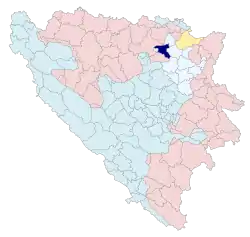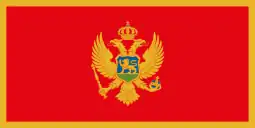Gračanica
Грачаница | |
|---|---|
| Grad Gračanica Град Грачаница City of Gračanica | |
 | |
 Coat of arms | |
 Location of Gračanica within Bosnia and Herzegovina. | |
| Coordinates: 44°41′21″N 18°18′08″E / 44.68917°N 18.30222°E | |
| Country | |
| Entity | Federation of Bosnia and Herzegovina |
| Canton | |
| Government | |
| • Mayor | Nusret Helić (SDP BiH) |
| Area | |
| • City | 216 km2 (83 sq mi) |
| Population (2013 census) | |
| • City | 45,220 |
| • Density | 210/km2 (540/sq mi) |
| • Urban | 13,400 |
| Time zone | UTC+1 (CET) |
| • Summer (DST) | UTC+2 (CEST) |
| Area code | +387 35 |
| Website | www |
Gračanica (Cyrillic: Грачаница) is a city located in Tuzla Canton of the Federation of Bosnia and Herzegovina, an entity of Bosnia and Herzegovina. It is located in northeastern Bosnia and Herzegovina, east of Doboj and west of Tuzla. As of 2013, it has a population of 45,220 inhabitants.
Gračanica
Gračanica is located in the lower valley of the River Sokoluša along the main road from Tuzla to Doboj, about 50 km west of Tuzla.
Settlements
History
The earliest documented references to Gračanica date back to 1528 in Turkish archives, where it was identified for its iron mine. Approximately 4 km (2.5 mi) from the town, a medieval fortress named Sokol existed. Gračanica attained town status in 1548. During the 17th century, it underwent expansion facilitated by Ahmed-paša Budimlija, who constructed the White Mosque, a public bath, and a clock tower. Under the Austrian Empire, Gračanica witnessed substantial economic, urban, and cultural advancements. From 1929 to 1941, Gračanica was part of the Vrbas Banovina within the Kingdom of Yugoslavia.
Climate
In January, the average temperature is 1.8 °C (35.2 °F), while in July, it rises to 23.3 °C (73.9 °F).
This region is known for its limited precipitation, with an annual average of 830mm/m2. The highest precipitation occurs in May (121mm) and June (101mm), while March records the lowest (41mm). Snowfall is most frequent in January, February, and March, with an average of 50 days per year. Gračanica exhibits a continental climate type.
Demographics
Population
| Population of settlements – Gračanica municipality | ||||||
|---|---|---|---|---|---|---|
| Settlement | 1961. | 1971. | 1981. | 1991. | 2013. | |
| Total | 30,203 | 46,950 | 54,311 | 59,134 | 45,220 | |
| 1 | Babići | 1,831 | 1,897 | |||
| 2 | Doborovci | 1,999 | 1,854 | |||
| 3 | Donja Lohinja | 1,091 | 1,149 | |||
| 4 | Džakule | 2,306 | 1,929 | |||
| 5 | Gračanica | 9,477 | 12,103 | 12,712 | 13,400 | |
| 6 | Lendići | 318 | 237 | |||
| 7 | Lukavica | 3,231 | 2,762 | |||
| 8 | Malešići | 2,964 | 2,853 | |||
| 9 | Miričina | 2,517 | 2,266 | |||
| 10 | Orahovica Donja | 4,304 | 3,966 | |||
| 11 | Orahovica Gornja | 2,035 | 1,771 | |||
| 12 | Piskavica | 808 | 720 | |||
| 13 | Pribava | 1,682 | 2,096 | |||
| 14 | Prijeko Brdo | 464 | 386 | |||
| 15 | Rašljeva | 758 | 691 | |||
| 16 | Škahovica | 1,423 | 1,400 | |||
| 17 | Soko | 1,920 | 1,746 | |||
| 18 | Stjepan Polje | 3,347 | 3,466 | |||
| 19 | Vranovići | 1,074 | 1,001 | |||
Ethnic composition
| Ethnic composition – Gračanica city | |||||||
|---|---|---|---|---|---|---|---|
| 2013. | 1991. | 1981. | 1971. | ||||
| Total | 13,400 (100,0%) | 12,712 (100,0%) | 12,103 (100,0%) | 9,477 (100,0%) | |||
| Bosniaks | 10,282 (80,88%) | 9,604 (79,35%) | 8,225 (86,79%) | ||||
| Serbs | 1,169 (9,196%) | 1,000 (8,262%) | 934 (9,855%) | ||||
| Yugoslavs | 900 (7,080%) | 1,284 (10,61%) | 98 (1,034%) | ||||
| Others | 314 (2,470%) | 104 (0,859%) | 71 (0,749%) | ||||
| Croats | 47 (0,370%) | 67 (0,554%) | 99 (1,045%) | ||||
| Montenegrins | 31 (0,256%) | 34 (0,359%) | |||||
| Macedonians | 6 (0,050%) | 6 (0,063%) | |||||
| Albanians | 5 (0,041%) | 7 (0,074%) | |||||
| Slovenes | 1 (0,008%) | 2 (0,021%) | |||||
| Hungarians | 1 (0,008%) | 1 (0,011%) | |||||
| Ethnic composition – Gračanica municipality | ||||||||
|---|---|---|---|---|---|---|---|---|
| 2013. | 1991. | 1981. | 1971. | 1961. | ||||
| Total | 45,220 (100,0%) | 59,134 (100,0%) | 54,311 (100,0%) | 46,950 (100,0%) | 30,203 (100,0%) | |||
| Bosniaks | 43,857 (96,99%) | 42,599 (72,04%) | 38,189 (70,32%) | 33,135 (70,58%) | 20,726 (68,62%) | |||
| Others | 1,134 (2,508%) | 1,315 (2,224%) | 288 (0,530%) | 219 (0,466%) | 77 (0,250%) | |||
| Serbs | 157 (0,347%) | 13,558 (22,93%) | 13,226 (24,35%) | 13 135 (27,98%) | 8,543 (28,29%) | |||
| Croats | 72 (0,159%) | 132 (0,223%) | 135 (0,249%) | 199 (0,424%) | 171 (0,570%) | |||
| Yugoslavs | 1,530 (2,587%) | 2,359 (4,344%) | 184 (0,392%) | 686 (2,270%) | ||||
| Montenegrins | 50 (0,092%) | 45 (0,096%) | ||||||
| Roma | 24 (0,044%) | 1 (0,002%) | ||||||
| Albanians | 20 (0,037%) | 10 (0,021%) | ||||||
| Macedonians | 13 (0,024%) | 9 (0,019%) | ||||||
| Slovenes | 5 (0,009%) | 7 (0,015%) | ||||||
| Hungarians | 2 (0,004%) | 6 (0,013%) | ||||||
Notable people
- Branko Cvetković, basketball player
- Muhamed Konjić, football player
- Mitar Lukić, football player
- Vedin Musić, football player
- Arminka Helić, politician
Twin towns – sister cities
 Fleury-les-Aubrais, France
Fleury-les-Aubrais, France Formia, Italy
Formia, Italy Pljevlja, Montenegro
Pljevlja, Montenegro
Sports
- NK Bratstvo Gračanica, an association football club
- RK Gračanica, a handball club
References
- ↑ "Grad (Menu) → Bratimljeni gradovi". gracanica.gov.ba (in Bosnian). Gračanica. Retrieved 2019-12-23.
- Official results from the book: Ethnic composition of Bosnia-Herzegovina population, by municipalities and settlements, 1991. census, Zavod za statistiku Bosne i Hercegovine - Bilten no.234, Sarajevo 1991.
